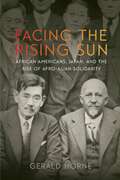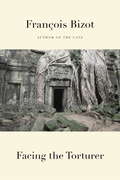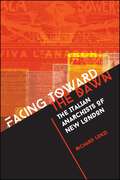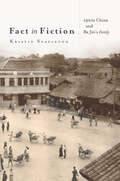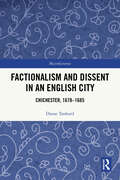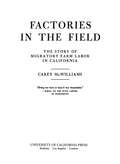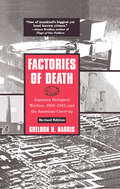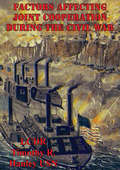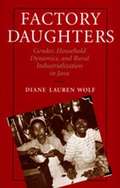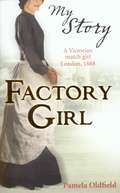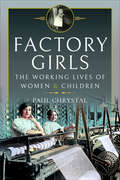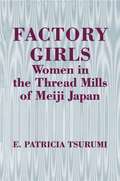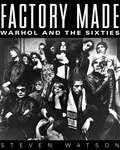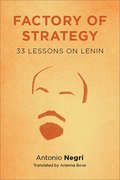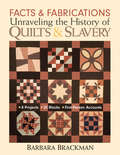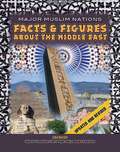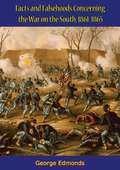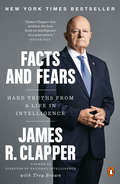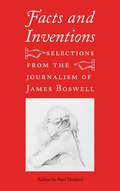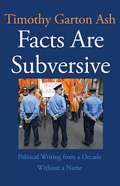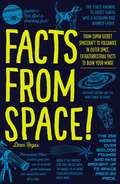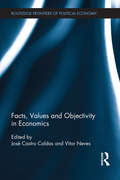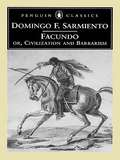- Table View
- List View
Facing the Rising Sun: African Americans, Japan, and the Rise of Afro-Asian Solidarity
by Gerald HorneThe surprising alliance between Japan and pro-Tokyo African Americans during World War II In November 1942 in East St. Louis, Illinois a group of African Americans engaged in military drills were eagerly awaiting a Japanese invasion of the U.S.— an invasion that they planned to join. Since the rise of Japan as a superpower less than a century earlier, African Americans across class and ideological lines had saluted the Asian nation, not least because they thought its very existence undermined the pervasive notion of “white supremacy.” The list of supporters included Booker T. Washington, Marcus Garvey, and particularly W.E.B. Du Bois. Facing the Rising Sun tells the story of the widespread pro-Tokyo sentiment among African Americans during World War II, arguing that the solidarity between the two groups was significantly corrosive to the U.S. war effort. Gerald Horne demonstrates that Black Nationalists of various stripes were the vanguard of this trend—including followers of Garvey and the precursor of the Nation of Islam. Indeed, many of them called themselves “Asiatic”, not African. Following World War II, Japanese-influenced “Afro-Asian” solidarity did not die, but rather foreshadowed Dr. Martin Luther King’s tie to Gandhi’s India and Black Nationalists’ post-1970s fascination with Maoist China and Ho’s Vietnam. Based upon exhaustive research, including the trial transcripts of the pro-Tokyo African Americans who were tried during the war, congressional archives and records of the Negro press, this book also provides essential background for what many analysts consider the coming “Asian Century.” An insightful glimpse into the Black Nationalists’ struggle for global leverage and new allies, Facing the Rising Sun provides a complex, holistic perspective on a painful period in African American history, and a unique glimpse into the meaning of “the enemy of my enemy is my friend.”
Facing the Torturer
by Francois Bizot Charlotte Mandell Antoine AudouardThe author of the acclaimed memoir The Gate now gives us a mesmerizing account of his personal relationship with one of the most infamous torturers of the twentieth century, and of his transformative experience observing and participating in that man's recent trial for war crimes. In 1971, François Bizot was researching Khmer pottery and Buddhist ritual in rural Cambodia when, along with two Cambodian assistants, he was arrested by Communist guerrillas on suspicion of being an American spy. In captivity, Bizot would establish an unlikely rapport with his interrogator, Comrade Duch, a twenty-nine-year-old former math teacher, now commander of the jungle encampment. After many long conversations, Duch would become convinced of Bizot's innocence, finally deciding to release his prisoner against the wishes of his superiors, including one Saloth Sar--the future Pol Pot. And so it was on Christmas Day 1971 that Bizot was allowed to depart the camp but obliged to leave his assistants behind. In 1999, Bizot would hear of the arrest of the "butcher of Tuol Sleng." This was the nom de guerre that Comrade Duch had earned after releasing Bizot and proceeding to exterminate some ten thousand Cambodians, including Bizot's assistants, Lay and Son. Duch's unexpected capture after years in hiding presented François Bizot with his first opportunity to confront the man who'd held him captive for three months and whose strange sense of justice had resulted in Bizot's being the only Westerner to survive imprisonment by the Khmer Rouge. The arrest also forced Bizot to confront a paradox: How could the man who'd been his savior have become one of the most monstrous perpetrators of the Cambodian genocide? Taking part in the trial as a witness, with Duch the sole defendant, would return Bizot to the heart of darkness. This is the testimony of what he discovered--about the torturer and about himself--on that harrowing journey.From the Hardcover edition.
Facing toward the Dawn: The Italian Anarchists of New London (SUNY series in Italian/American Culture)
by Richard LenziIn the early twentieth century, the Italian American radical movement thrived in industrial cities throughout the United States, including New London, Connecticut. Facing toward the Dawn tells the history of the vibrant anarchist movement that existed in New London's Fort Trumbull neighborhood for seventy years. Comprised of immigrants from the Marche region of Italy, especially the city of Fano, the Fort Trumbull anarchists fostered a solidarity subculture based on mutual aid and challenged the reigning forces of capitalism, the state, and organized religion. They began as a circle within the ideological camp of Errico Malatesta and evolved into one of the core groupings within the wing of the movement supporting Luigi Galleani. Their manifold activities ranged from disseminating propaganda to participating in the labor movement; they fought fascists in the streets, held countless social events such as festas, theatrical performances, picnics and dances, and hosted militant speakers, including Emma Goldman. Focusing on rank-and-file militants—carpenters, stonemasons, fishermen, housewives—rather than well-known figures, Richard Lenzi offers a microhistory of an ethnic radical group during the heyday of labor radicalism in the United States. He also places that history in the context of the larger radical movement, the Italian American community, and greater American society, as it moved from the Gilded Age to the New Deal and beyond.
Fact in Fiction: 1920s China and Ba Jin’s Family
by Kristin StapletonHistorical novels can be windows into other cultures and eras, but it's not always clear what's fact and what's fiction. Thousands have read Ba Jin's influential novel Family, but few realize how much he shaped his depiction of 1920s China to suit his story and his politics. In Fact in Fiction, Kristin Stapleton puts Ba Jin's bestseller into full historical context, both to illustrate how it successfully portrays human experiences during the 1920s and to reveal its historical distortions. Stapleton's attention to historical evidence and clear prose that directly addresses themes and characters from Family create a book that scholars, students, and general readers will enjoy. She focuses on Chengdu, China, Ba Jin's birthplace and the setting for Family, which was also a cultural and political center of western China. The city's richly preserved archives allow Stapleton to create an intimate portrait of a city that seemed far from the center of national politics of the day but clearly felt the forces of--and contributed to--the turbulent stream of Chinese history.
Factionalism and Dissent in an English City: Chichester, 1678-1685 (Microhistories)
by Danae TankardThis book is about the political and religious controversies that beset the small English city of Chichester between 1678 and 1685, which intersected with wider political turbulence at the heart of government and in the nation at large. This period of seventeenth-century English history has been overshadowed by the more dramatic events of the English Civil War and the Glorious Revolution, but these years were marked by repeated political crises, assassination plots, religious persecution, and fears of a new civil war. Telling this story through the lives of the inhabitants of one city offers an intimate view of how these events played out in a particular locality.As much a work of social history as it is of political history, this book has the lives of individual men and women at its core. The story that unfolds includes a strong cast of characters and has multiple points of high drama: it is the individuals and the events they were caught up in that propel the narrative forwards.Factionalism and Dissent in an English City makes a significant contribution to the historiography of late Restoration England. Its plot-and character-driven narrative structure also makes the book accessible to a non-specialist reader who wants to find out what it might have been like to live through these challenging years.
Factories in the Field
by Carey Mcwilliams Douglas C. SackmanThis book was the first broad exposé of the social and environmental damage inflicted by the growth of corporate agriculture in California. Factories in the Field--together with the work of Dorothea Lange, Paul Taylor, and John Steinbeck--dramatizes the misery of the dust bowl migrants hoping to find work in California agriculture. McWilliams starts with the scandals of the Spanish land grant purchases, and continues on to examine the experience of the various ethnic groups that have provided labor for California's agricultural industry--Chinese, Japanese, Mexicans, Filipinos, Armenians--the strikes, and the efforts to organize labor unions
Factories of Death: Japanese Biological Warfare, 1932-45 and the American Cover-Up
by Sheldon H. HarrisFactories of Death details the activities of the Japanese army scientists that conducted numerous horrifying experiments upon live human beings. It investigates who from the upper echelons of the Japanese military and political establishments knew of the experiments, also the question of whether or not Allied POWs were subjected to such tests, and the nature of the deal that was brokered with US authorities after the war. This new edition has been completely updated, and contains an entirely new chapter detailing the numerous revelations that have surfaced since the book's initial publication in 1994.
Factors Affecting Joint Cooperation During The Civil War
by LCDR Timothy R. Hanley USNThis study is a historical analysis of selected joint Army Navy operations conducted along the East Coast during the American Civil War. It begins with a description of the ante-bellum conditions of the Army and Navy and the organizational structure of the War and Navy Departments. Three joint operations are analyzed; the Fort Sumter Relief Expedition of 1861, the Port Royal Expedition of 1862, and the Charleston Campaign of 1863.In none of the joint operations covered by this study was there a unified command structure between the Army and Navy. Mutual support between the services was dependent upon voluntary cooperation between the respective service commanders.This study determines what factors influenced the degree of cooperation between the service commanders of joint operations during the Civil War. Many of the factors which either facilitated or hindered joint cooperation during that time could affect contemporary joint operations, particularly in the early stages before a unified command structure is established. An appreciation of those factors is both helpful in understanding the outcome of Civil War joint operations as well as providing some insight into the problems faced by contemporary commanders in a joint environment.
Factory Daughters: Gender, Household Dynamics, and Rural Industrialization in Java
by Diane Lauren Wolf"Factory Daughters" is distinguished by wide-ranging fieldwork in Java and a combination of narratives, rigorous surveys and quantitative analysis. In bringing us the words of many Javanese women, Wolf is able to vividly portray the ways they negotiate employment, income and marriage decisions through the webs of family obligations. The result is an effective contribution that deepens our understanding of industrialization and family life in the Third World.
Factory Girl (My Story Series)
by Pamela OldfieldEverybody knows the sad tale of the Little Match Girl, but less well known is the story of the girls and women who slaved fourteen hours a day in the match factories for appalling pay, only to contract such fatal complaints as phossy jaw. <P><P>The brutality of these conditions was brought to a head with the London Match Girls Strike of 1888. <P><P>Told from the perspective of a young factory worker, this new title offers a fascinating insight into Victorian child labour.
Factory Girls: The Working Lives of Women & Children
by Paul ChrystalEver since there have been factories women and children have, more often than not, worked in those factories. What is perhaps less well known is that women also worked underground in coal mines and overground scaling the inside of chimneys. Young children were also put to work in factories and coalmines; they were deployed inside chimneys, often half-starved so that they could shin up ever narrower flues. This book charts the unhappy but aspirational story of women and children at work through the Industrial Revolution to the beginning of the 20th century. Without women there would have been no pre-industrial cottage industries, without women the Industrial Revolution would not have been nearly as industrial and nowhere near as revolutionary. Many women, and children, were obliged to take up work in the mills and factories – long hours, dangerous, often toxic conditions, monotony, bullying, abuse and miserly pay were the usual hallmarks of a day’s work - before they headed homeward to their other job: keeping home and family together. This long overdue and much needed book also covers the social reformers, the role of feminism and activism and the various Factory Acts and trade unionism. We examine how women and children suffered chronic occupational diseases and disabling industrial injuries - life changing and life shortening – and often a one way ticket to the workhouse. The book concludes with a survey of the art, literature and the music which formed the soundtrack for the factory girl and the climbing boys.
Factory Girls: Women in the Thread Mills of Meiji Japan
by E. Patricia TsurumiInvestigating the enormous contribution made by female textile workers to early industrialization in Meiji Japan, Patricia Tsurumi vividly documents not only their hardships but also their triumphs. While their skills and long hours created profits for factory owners that in turn benefited the state, the labor of these women and girls enabled their tenant farming families to continue paying high rents in the countryside. Tsurumi shows that through their experiences as Japan's first modern factory workers, these "factory girls" developed an identity that played a crucial role in the history of the Japanese working class. Much of this story is based on records the factory girls themselves left behind, including their songs. "It is a delight to receive a meticulous and comprehensive volume on the plight of women who pioneered [assembly plant] employment in Asia a century ago...."--L. L. Cornell, The Journal of Asian Studies "Tsurumi writes of these rural women with compassion and treats them as sentient, valuable individuals.... [Many] readers will find these pages informative and thought provoking."--Sally Ann Hastings, Monumenta Niponica
Factory Made
by Steven WatsonFactory Made: Warhol and the Sixties is a fascinating look at the avant-garde group that came together--from 1964 to 1968--as Andy Warhol's Silver Factory, a cast that included Lou Reed, Nico, Edie Sedgwick, Gerard Malanga, Paul Morrissey, Joe Dallesandro, Billy Name, Candy Darling, Baby Jane Holzer, Brigid Berlin, Ultra Violet, and Viva. Steven Watson follows their diverse lives from childhood through their Factory years. He shows how this ever-changing mix of artists and poets, musicians and filmmakers, drag queens, society figures, and fashion models, all interacted at the Factory to create more than 500 films, the Velvet Underground, paintings and sculpture, and thousands of photographs. Between 1961 and 1964 Warhol produced his most iconic art: the Flower paintings, the Marilyns, the Campbell's Soup Can paintings, and the Brillo Boxes. But it was his films--Sleep, Kiss, Empire, The Chelsea Girls, and Vinyl--that constituted his most prolific output in the mid-1960s, and with this book Watson points up the important and little-known interaction of the Factory with the New York avant-garde film world. Watson sets his story in the context of the revolutionary milieu of 1960s New York: the opening of Paul Young's Paraphernalia, Truman Capote's Black and White Ball, Max's Kansas City, and the Beautiful People Party at the Factory, among many other events. Interspersed throughout are Watson's trademark sociogram, many black-and-white photographs--some never before seen--and quotes and slang that help define the Warholian world. With Factory Made, Watson has focused on a moment that transformed the art and style of a generation.With a new Introduction to the eBook Edition and outtakes from Steven Watson's Silver Factory interviews, 1999-2002. Note: The eBook edition includes 60 select photographs from the print edition.
Factory of Strategy
by Antonio Negri Arianna BoveFactory of Strategy is the last of Antonio Negri's major political works to be translated into English. Rigorous and accessible, it is both a systematic inquiry into the development of Lenin's thought and an encapsulation of a critical shift in Negri's theoretical trajectory.Lenin is the only prominent politician of the modern era to seriously question the "withering away" and "extinction" of the state, and like Marx, he recognized the link between capitalism and modern sovereignty and the need to destroy capitalism and reconfigure the state. Negri refrains from portraying Lenin as a ferocious dictator enforcing the poor's reappropriation of wealth, nor does he depict him as a mere military tool of a vanguard opposed to the ancien régime. Negri instead champions Leninism's ability to adapt to different working-class compositions in Russia, China, Latin America, and elsewhere. He argues that Lenin developed a new political figure in and beyond modernity and an effective organization capable of absorbing different historical conditions. Negri ultimately urges readers to recognize the universal application of Leninism today and its potential to institutionally -- not anarchically -- dismantle centralized power.
Factory of Strategy: Thirty-Three Lessons on Lenin (Insurrections: Critical Studies in Religion, Politics, and Culture)
by Antonio NegriFactory of Strategy is the last of Antonio Negri's major political works to be translated into English. Rigorous and accessible, it is both a systematic inquiry into the development of Lenin's thought and an encapsulation of a critical shift in Negri's theoretical trajectory.Lenin is the only prominent politician of the modern era to seriously question the "withering away" and "extinction" of the state, and like Marx, he recognized the link between capitalism and modern sovereignty and the need to destroy capitalism and reconfigure the state. Negri refrains from portraying Lenin as a ferocious dictator enforcing the proletariat's reappropriation of wealth, nor does he depict him as a mere military tool of a vanguard opposed to the Ancien Régime. Negri instead champions Leninism's ability to adapt to different working-class configurations in Russia, China, Latin America, and elsewhere. He argues that Lenin developed a new political figuration in and beyond modernity and an effective organization capable of absorbing different historical conditions. He ultimately urges readers to recognize the universal application of Leninism today and its potential to institutionally—not anarchically—dismantle centralized power.
Facts & Fabrications: From Practice To Perfection -- Troubleshooting Guide -- 50+ Designs
by Barbara Brackman“A renowned quilt historian . . . present[s] what she considers to be an accurate assessment of slavery, quilts and the Underground Railroad.” —TimeRecall an unforgettable phase of our nation’s history with America’s leading quilt historian. Barbara Brackman presents the most current research on the role of quilts during the time of slavery, emancipation, and the Underground Railroad. Nine quilt projects combine historic blocks with Barbara’s own designs.Did quilts really lead the way to freedom? What role did quilts play? Barbara explores the stories surrounding the Underground Railroad.Read about the people who were there! First-person accounts, newspaper and military records, and surviving quilts all add clues. YOU decide how to interpret the stories and history, fabrication and facts as you learn about this fascinating time in history. Excellent resource for elementary through high school learners—curriculum included! “Quilters interested in African American slavery and quilting will find many historically accurate, teachable moments within these pages. The first-personal accounts by slaves of their quilt making, quilt parties, and stolen quilts make emotional reading. A must-have book for your quilting library!” —Kyra Hicks, author of Black Threads“Brackman skillfully assembles accurate historical evidence along with beautiful quilt examples infused with slave-era symbolism.” —Dr. Carolyn Mazloomi, author of Threads of Faith“Many of persons featured or quoted are women with a connection to the ‘peculiar institution’: slaves, escaped slaves, freed slaves, plantation owners, abolitionists, and so forth . . . teaches history through quilting and offers fun projects for history-minded quilters . . . the stories offer good starting points for one’s own research and the projects are beautiful.” —Beth’s Bobbins
Facts & Figures About the Middle East
by Lisa MccoyThe history of the Middle East is long and complex. In the MAJOR MUSLIM NATIONS series, the term "Middle East" refers to the region encompassing 23 countries?Algeria, Bahrain, Djibouti, Egypt, Iran, Iraq, Israel, Jordan, Kuwait, Lebanon, Libya, Mauritania, Morocco, Oman, Qatar, Saudi Arabia, Somalia, Sudan, Syria, Tunisia, Turkey, United Arab Emirates, and Yemen.This book provides an overview of the history of the Middle Eastern countries, along with information about the region's geography, central religious beliefs, governments and economies of the various states, cultural groups, and important communities.
Facts and Fables: The Arab-Israeli Conflict
by Clifford A. WrightMany western people view the Arabs and Israelis as a constantly warring group. Is this so? If so, why? If not, what are the facts and myths surrounding these two peoples? Read this book to find out!
Facts and Falsehoods Concerning the War on the South, 1861-1865
by George EdmondsElizabeth Avery Meriwether was the author of many books, giving accurate and vivid descriptions of historical incidents of importance in the South. Her plots were widely regarded as skillfully conceived and developed, told with remarkable vigor, and true pictures of conditions that were passing away, making her books important additions to the literature of old Southern life.“Facts and Falsehoods Concerning the War of the South of 1861 and 1865,” which she wrote under the pen name George Edmonds and first published in 1904, was considered by Meriwether herself to be the most valuable book that she ever wrote or could write, because in it she told the truth about historical events:“This little work is offered. It does not aspire to the dignity of History. It is mostly a collection of facts under one cover, which I trust will prove of use to the future historians of the South. Perhaps the fittest title to this work would be “A Protest Against Injustice”—the injustice of misrepresentation—of false charges—of lies. The feeling of injustice certainly inspired the idea of this work. The greater number of the facts herein laid before the reader were not drawn from Southern or Democratic sources, but from high Republican authorities. Part first of this work presents Abraham Lincoln to the people of this generation as his contemporaries saw and knew him. The characteristics portrayed will be a revelation to many readers.”
Facts and Fears: Hard Truths from a Life in Intelligence
by James R. Clapper Trey BrownThe former Director of National Intelligence's candid and compelling account of the intelligence community's successes--and failures--in facing some of the greatest threats to America <P><P>When he stepped down in January 2017 as the fourth United States director of national intelligence, James Clapper had been President Obama's senior intelligence adviser for six and a half years, longer than his three predecessors combined. He led the U.S. intelligence community through a period that included the raid on Osama bin Laden, the Benghazi attack, the leaks of Edward Snowden, and Russia's influence operation during the 2016 U.S. election campaign. <P>In Facts and Fears, Clapper traces his career through the growing threat of cyberattacks, his relationships with presidents and Congress, and the truth about Russia's role in the presidential election. He describes, in the wake of Snowden and WikiLeaks, his efforts to make intelligence more transparent and to push back against the suspicion that Americans' private lives are subject to surveillance. <P>Finally, it was living through Russian interference in the 2016 presidential election and seeing how the foundations of American democracy were--and continue to be--undermined by a foreign power that led him to break with his instincts honed through more than five decades in the intelligence profession to share his inside experience. <P>Clapper considers such controversial questions as, Is intelligence ethical? Is it moral to intercept communications or to photograph closed societies from orbit? What are the limits of what we should be allowed to do? What protections should we give to the private citizens of the world, not to mention our fellow Americans? Are there times when intelligence officers can lose credibility as unbiased reporters of hard truths by inserting themselves into policy decisions? <P>Facts and Fears offers a privileged look inside the U.S. intelligence community and, with the frankness and professionalism for which James Clapper is known, addresses some of the most difficult challenges in our nation's history. <P><b>A New York Times Bestseller</b>
Facts and Inventions
by James Boswell Paul TankardJames Boswell (1740-1795), best known as the biographer of Samuel Johnson, was also a lawyer, journalist, diarist, and an insightful chronicler of a pivotal epoch in Western history. This fascinating collection, edited by Paul Tankard, presents a generous and varied selection of Boswell's journalistic writings, most of which have not been published since the eighteenth century. It offers a new angle on the history of journalism, an idiosyncratic view of literature, politics, and public life in late eighteenth-century Britain, and an original perspective on a complex and engaging literary personality.
Facts are Subversive
by Timothy Garton Ash'During times of universal deceit', wrote George Orwell, 'telling the truth becomes a revolutionary act. ' For more than thirty years, Timothy Garton Ash has traveled among truth tellers and political charlatans to record, with scalpel-sharp precision, what he has found. This book confirms his reputation as our foremost historian of the present. Facts are Subversive contains Garton Ash's eye-witness accounts of the fate of countries, including Serbia, Poland and Ukraine, making the transition from dictatorship to democracy, and his dispatches from places such as Egypt, Burma and Iran, where that transformation has yet to take place. A recurring theme, of the book and the decade, is freedom and its discontents. An encounter with the drug gangs of Sao Paulo raises disturbing questions about liberal democracy; his examination of immigration and Islam in Europe challenges the clichés of multiculturalism. Often humorous mini-essays, selected from his columns in the Guardian, rub shoulders with in-depth treatments of subjects including Günter Grass, George Orwell and Isaiah Berlin. Facts are Subversive also includes Garton Ash's most recent reportage on the election of Barack Obama and its implications for the world.
Facts from Space!: From Super-Secret Spacecraft to Volcanoes in Outer Space, Extraterrestrial Facts to Blow Your Mind!
by Dean RegasA guided tour through the universe--and beyond! From the sun's super-hot core to the many moons of Neptune, we're traveling to the far reaches of our solar system and beyond! Astronomer Dean Regas presents Facts from Space!--an exciting education on everything outside our atmosphere. Inside, you'll discover space facts and celestial trivia, including:A day on Venus is longer than its year.Early space missions ejected human waste into space, where it froze into intricate crystals that still float in space today.After being in space, some astronauts returned to Earth up to 2 inches taller than when they left.The stars in the Big Dipper are shifting among themselves and will look like a "Big Spatula" by the year 75,000.And more!Packed with fascinating information, it's a stellar read for sci-fi fans and at-home astronomers alike!
Facts, Values and Objectivity in Economics (Routledge Frontiers of Political Economy)
by José Castro Caldas Vítor NevesIs Economics an ‘objective’ or ‘positive’ science, independent of ethical and political positions? The financial crisis that began in 2007 gave rise to renewed doubts regarding the ‘objectivity’ of economics and brought into the public arena a debate that was previously confined to academia. A remarkable feature of the public debate on the value neutrality of economics since then was that it not only involved indictments of ideological biases in economic theory, but also the attribution of the crisis itself to the unethical orientation of economic agents, of economists acting as experts and of ‘economic science’ itself. The contributors to this volume believe that economists of all persuasions are once again compelled to probe the normative foundations of their discipline and give a public account of their doubts and conclusions.
Facundo
by Domingo F. SarmientoOstensibly a biography of the gaucho barbarian Juan Facundo Quiroga, Facundo is also a complex, passionate work of history, sociology, and political commentary, and Latin America's most important essay of the nineteenth century. .
